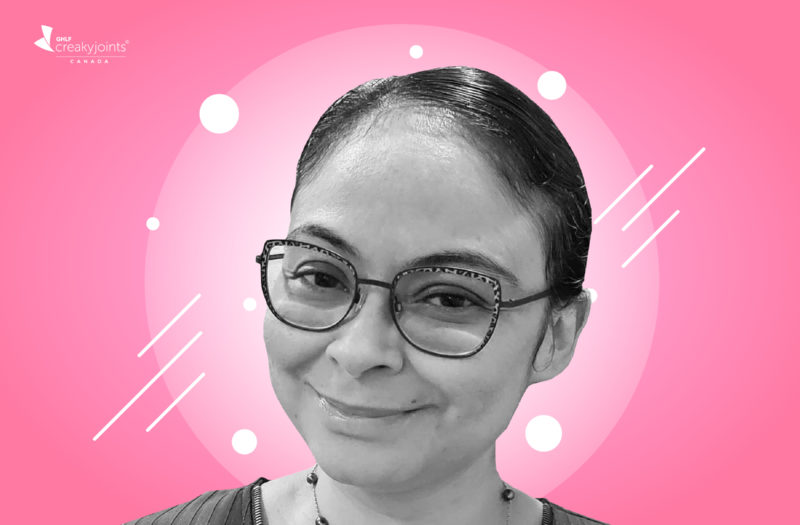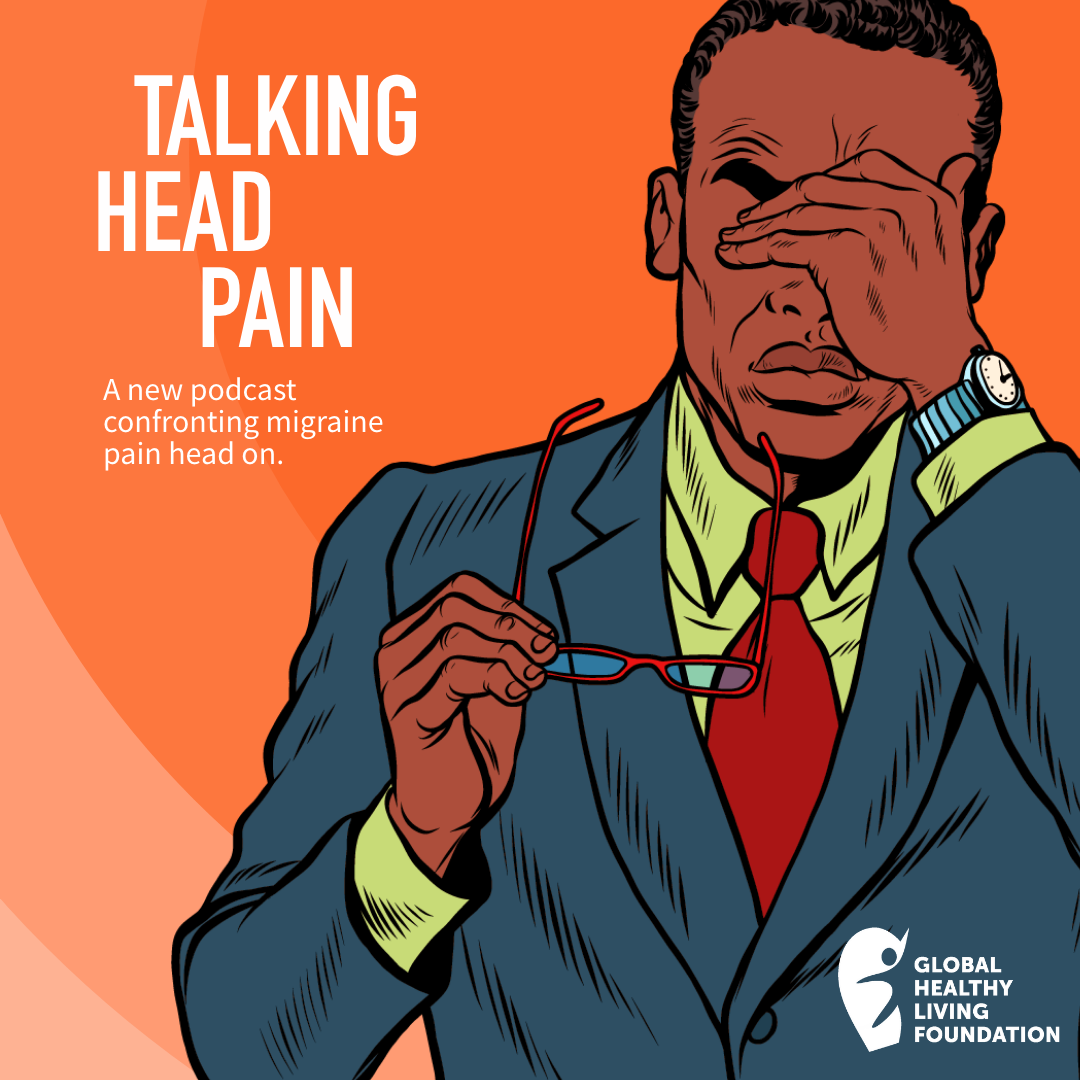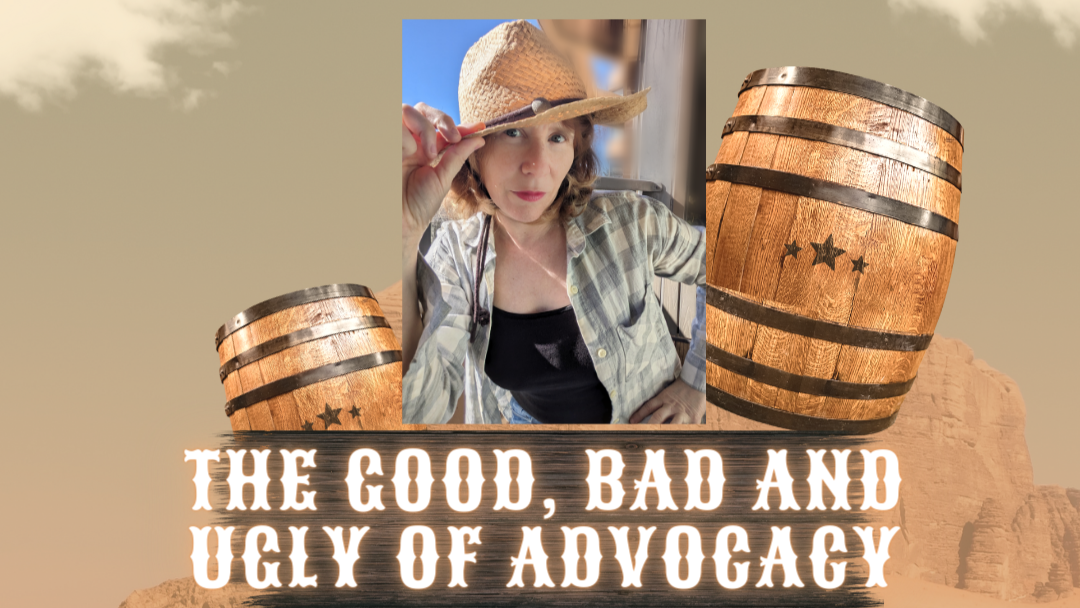This story was told to CreakyJoints Canada by Cristina Montoya, a 39-year-old registered dietitian and holistic cannabis practitioner who lives in Ontario, Canada with her husband and son. Cristina is an active advocate for the arthritis and Sjögren’s syndrome communities and creator of Arthritis Dietitian, a nutrition blog focused on plant-based anti-inflammatory eating to help those living with chronic pain and fatigue.
Here is Cristina’s story of being diagnosed with RA in her native Colombia at 22, and then later going through treatment in Canada.
In my early 20s, I was living in Colombia and finishing my fourth year of undergrad. I worked as a caregiver on the weekends, and one day, as I was assisting a woman into a cab, my finger got trapped in the car door. Obviously, it hurt. Not long after the incident, I started experiencing really bad headaches.
At first, I didn’t connect the two ailments. But two weeks later my knees started to hurt, followed soon after by my ankles. I tried to explain the pain away, putting the blame on my building’s broken elevator. “Oh, it must be going up and down all those stairs,” I thought. Occasionally I’d shift the blame to my exercise routine, chalking up sore muscles and joints to a tough run.
Then suddenly, the pain appeared in my elbows. And to add to the growing list of symptoms, my fingers became swollen, resembling sausages.
I went to my community doctor, and he began to put the pieces of my painful puzzle together. He referred me to a rheumatologist, who tested me and later diagnosed me with rheumatoid arthritis (RA).
I consider myself one of the lucky ones. After all, it takes many people years before they know what’s going on with their bodies. I felt so fortunate that my diagnosis came within months of my starting to feel symptoms. What I didn’t realize at the time, however, was that I had actually been living with another, different autoimmune disease for 12 years: Sjögren’s syndrome.
Always the Sick Kid
As a child, I was constantly sick. The glands under my eyes would frequently swell, leading my doctor to diagnose with me mumps, which were still common in Colombia at the time. But after being diagnosed with mumps for a fifth time, a different doctor started to search for what else might be wrong.
Swollen glands weren’t my only problem. I always had digestive issues, like abdominal pain, heartburn, diarrhea, and constipation. Sometimes, I would just throw up without warning or any type of nausea. I constantly felt “dry,” and I couldn’t produce tears when I cried. My throat would hurt to the point where I couldn’t swallow. My teeth started to deteriorate. I had a laundry list of symptoms that couldn’t be connected.
Fast forward to the year of my RA diagnosis, and finally I had an explanation for those symptoms, too: Sjögren’s syndrome, an autoimmune disease that attacks the glands that make tears and saliva. They did an X-ray of my salivary glands, used dye in my eyes to measure the volume of tears I made, and did a small salivary gland biopsy. I met all the criteria: I made little to no tears, produced very little saliva, and my labs were positive for antibodies associated with Sjögren’s. I was basically a textbook case.
After a lifetime of mystery symptoms, I now had not only one, but two diagnoses for chronic inflammatory conditions.
It was time to figure out treatment.
Recognizing the Physical Cost of Inaccessible Treatment
The doctors diagnosed me with moderate to severe RA, which had started to cause hand deformities. As a result, they decided to focus on treating my RA symptoms before addressing the Sjögren’s. I started with a heavy dose of the steroid prednisolone, NSAIDS like ibuprofen, and opioids like morphine. Much later, I began anti-inflammatory eye drops to help deal with my dry eye for my Sjögren’s.
When the RA treatments failed to produce the desired results, they put me on different disease-modifying antirheumatic drugs (DMARDs), which help reduce the immune system overactivity causing my RA symptoms. I started with methotrexate pills, but I soon switched to the injections after a poor reaction. Then I cycled through cyclosporine and hydroxychloroquine — I think I was given every “old-school” treatment there is except for gold salts. Still, none of them worked. I was always in unbearable pain.
As a student in a health field, I was very proactive in researching RA. Because Google didn’t exist at the time, I learned about RA through connecting and talking with experts — a privilege I was afforded because of my area of studies.
It was at a conference in Colombia that I learned about biologics and what they could do for people with rheumatoid arthritis. Brand-new at the time, biologic medications target specific parts of the immune system to reduce inflammation and treat inflammatory conditions like RA. But biologics weren’t yet widely available, making the process to access them incredibly long and complicated.
They weren’t covered by standard health insurance, just expensive private insurance. But even if you could access and afford biologics, there was a chance it could get discontinued, and your whole therapy regimen would be disrupted.
This made me aware of the inaccessibility and inequality that exists in the health care system and has impacted that way I seek treatment.
Navigating a New Country — and Health Care System
In 2007, three years after my diagnosis, my husband and I decided to move to Canada from Colombia. I organized all my medical files for the move and brought the filled folders to my new doctor. When he saw what I’d been taking – and that I hadn’t yet been given a biologic— he said I didn’t need to continue with my current treatment, and moved me to a biologic.
In order to get on a biologic, I had to fill out an application with the Trillium Drug Program, a publicly funded program that helps Ontario residents pay the cost of expensive prescription drugs. The amount they subsidize is in relation to your household income. But before they’ll approve you for biologics, you have to try certain other therapies first. The program responded to my doctor and said they wouldn’t fund a biologic until I tried leflunomide (Arava), a drug similar to Plaquenil (which I had already taken in Colombia).
I was on it for three months and didn’t see any progress. I just felt terrible. Finally, I was approved for the biologic Humira (adalimumab).
Suddenly, a switch was flipped, and things started to change. It worked beautifully. I couldn’t believe how different I felt. A week after I had the first injection, my morning stiffness was gone, and I no longer had that imaginary weight pulling me down to stay in bed. I started going for long walks at 6 a.m. like I used to before my diagnosis. The only pain that remained was from my deformed joints, but my generalized debilitating pain was gone. I was finally able to function without my husband having to change my clothes, feed me, comb my hair, or take me to the bathroom.
After a year, they switched me to a different biologic, Cimzia (certolizumab pegol), which I’ve been on ever since. I still struggle with fatigue from time to time, but for the most part the medication manages my other RA symptoms, like pain, stiffness, and swelling.
It’s interesting to look back at the difference in rheumatoid arthritis care in two countries. Though I couldn’t access biologics in Colombia, I felt I was getting proper treatment according to the resources and guidelines they had at the time of my diagnosis. I was lucky, too, that the doctors didn’t ignore my pain.
In Canada, however, I have been able to receive treatment but not compassion. I’ve experienced and seen the lack of support given to women with chronic pain, especially women who rely solely on government insurance to pay for prescription medications.
Becoming a Chronic Illness Advocate
Although I was very curious about rheumatoid arthritis following my diagnosis, I didn’t want it to be my sole focus. I also didn’t want it to define me. So I did my best to keep it private from family, friends, and colleagues.
I had the same attitude toward my Sjögren’s diagnosis. But that shifted in 2015 when the Sjögren’s Society of Canada, unaware that I had the condition, asked me to speak about nutrition at an event. In hearing stories from attendees, I instantly felt a connection; we understood each other, sharing the same language of pain and fatigue.
I wanted to have the same experience in the RA world. I started volunteering with the Arthritis Society and connecting with other RA patients through support groups and online communities. Again, we shared a language and experience. There’s mutual relief that comes through sharing and hearing that someone else understands exactly what you are going through. It’s what has motivated me to open up about RA, not just with other patients but with loved ones, too.
Using My Nutrition Knowledge to Help Others with RA
Part of my rheumatoid arthritis experience has been learning how food affects my symptoms, something I didn’t start to pay attention to until I moved to Canada.
In Colombia, my diet consisted of fresh produce and protein. But in Canada, I started eating more processed and preserved food. (Also, fast food. Those salty McDonald’s fries are as tasty as they are triggering.) I felt sick constantly in that first year.
Once I realized the connection food had to my flares, I used my skills as a dietitian to heal my gut. I studied the components of Mediterranean diet — olive oils, fruits, veggies, whole grains, beans, and fish — and learned how this diet could guide my body back to toward health. Is it a cure? No. But it’s one of many treatments that helps me manage my rheumatoid arthritis.
About four years after moving to Canada, I was also diagnosed with fibromyalgia. The medications I took for it were making me feel sick. My husband suggested I try medical cannabis. My first response was “Are you kidding me?” But ultimately, I decided to give it a try. The cannabis helped me manage the neuropathic pain — the feeling of needles hugging my back — from the fibromyalgia. To say I was a convert would be an understatement. In fact, during the COVID-19 pandemic, I decided to take a course about medical cannabis and how to use it, and became a Holistic Cannabis Practitioner. I discovered all the ways cannabis can help people with chronic pain conditions. I also found out that even though cannabis is accessible, it still carries stigma, and people also don’t really understand the benefits of it.
That morphed into the creation of EduCanNation, a group of women certified in cannabis education who use evidence-based knowledge to develop resources to educate patients, teach them how to navigate the medical cannabis industry in Canada, and help reduce stigma so more people can understand why it’s helpful.
Just like good nutrition, cannabis isn’t a miracle solution. It won’t reset your immune system or make your RA disappear. I use it to help manage pain, anxiety, and sleep, which helps give me more energy to focus on the other pieces of my RA treatment plan. It’s just another tool in my RA toolkit.
My Advice for Others Living with Rheumatoid Arthritis
Look beyond your physical care
In addition to medication to manage the physical symptoms of RA, I think newly diagnosed patients should also pay attention to their mental health and consider seeing a therapist, preferably someone who has experience treating people with chronic pain or illness. Having someone help you through the process of grieving what was and accepting what’s to come is vital and invaluable.
Release your guilt
You might feel like you caused your RA somehow and wonder what you did to deserve this. But it’s not your fault. If you can let go of that mental burden, it can make a huge difference.
Use your voice when you’re ready
There are people being diagnosed with RA every day. Sharing your experience can help others feel less alone, and it may give them the push to keep looking for the right treatment when nothing seems to be working. Connection is therapeutic, and you can be that connection point for someone else.
If I Could Say One Thing to My Newly Diagnosed Self
Take time to heal your body. You don’t need to make other people believe you’re Wonder Woman. Instead of pushing through, pause, listen to your body, and find out what works best to manage your rheumatoid arthritis. Life will still be there after you figure out what you need in order to control your symptoms.
Stay in Touch with CreakyJoints Canada
Part of the nonprofit Global Healthy Living Foundation, CreakyJoints is a digital community for millions of arthritis patients and caregivers worldwide who seek education, support, advocacy, and patient-centered research. All of our programming and services are always provided free of charge. As we grow CreakyJoints Canada we want to hear from you. Please join our email list to stay connected, learn about new content and initiatives, and send us suggestions and ideas.






